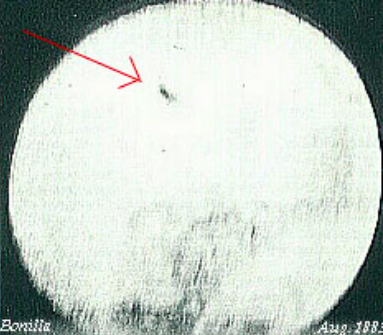1883: The Year the World Almost Ended

A picture taken by Jose Bonilla, A Strange Moving Spot Appears in Front of the Sun.
January 30, 2019
The year was 1883, and on August 12th and 13th something very peculiar happened. In a small observatory in Mexico, a scientist by the name of Jose Bonilla was looking through his telescope studying the sun. What he saw was something mind-boggling. Suddenly, he began to observe countless UFOs (not aliens but unidentified objects) that looked like black spots flying across the face of the sun. Some objects were surrounded by a mist-like haze, and Bonilla counted some 450 objects in total. He nor anyone else at the time could explain what these objects were, and so when he published his findings in a French Journal, the objects were written off as if something had passed in front of the telescope, such as high-flying birds, insects, or dust. What no one knew was that these spots were much more than birds and that they had just avoided a terrible crisis.
If you know anything about space bodies at all, then perhaps this misty shroud around the bodies will sound familiar. It sounds very similar to the trail of a comet, being the only bodies that we know to exhibit this trail-like behavior. It is believed that Bonilla saw fragments of a broken up comet flying in front of the sun. In 2006, scientists observed a phenomenon just like this, in which a comet broke up into pieces, which scattered.
It is odd to think that Bonilla was the only person to observe these fragments. Therefore, scientists have used the idea of parallax to legitimize it. Basically, parallax is the idea that objects will appear to look different when viewed from different angles. Pretty simple, but there is a problem with this idea. Space is very vast, so how could opposing angles make any difference? Even so, parallax shows that even in areas close by, other observers may not have been able to see these objects from the angle from which they were viewing, as opposed to Bonilla, who had a clear view. However, one thing must be true in order for this theory to work. For the idea of parallax to work, the objects must have been very close to the Earth, so that from different angles they would not be sighted.
“What is so important about these fragments?” you may be asking yourself. The answer is this, if things had happened differently, you might not have been here to ask that question. Simply put, the earth avoided total disaster over those days. These UFOs were fragments of a comet, but judging from the size of the pieces, this parent comet must have weighed over a billion tons (1 billion tons is 2 with 12 zeros in pounds). To put that in perspective, the Eiffel Tower weighs roughly 7300 tons (meaning that about 136,000 Eiffel Towers weigh as much as this comet). It is estimated that this massive comet broke up into well over 3000 pieces, ranging from about 50-1000 meters (164-3280 feet) in diameter. To give you an idea of how large those pieces are, a football field is 100 yards, or 300 feet. The largest of these pieces could have measured up to almost 11 football fields in diameter. While the Earth itself weighs about 6 sextillion tons (6 with 21 zeros), these pieces of the comet were thought to have been anywhere from 600 to 8000 km away from hitting the Earth (372-5000 miles). In terms of the sheer size of space, this amount of distance is nothing.
Even just one of these pieces out of the over 3000 hitting the Earth would have resulted in millions of casualties, with the explosion of just one being able to destroy a sizable portion of Europe. Had all of these pieces or even a large amount of them struck the Earth, a mass extinction event much like the one which killed the dinosaurs could have occurred. All life as we know it was saved that day.
